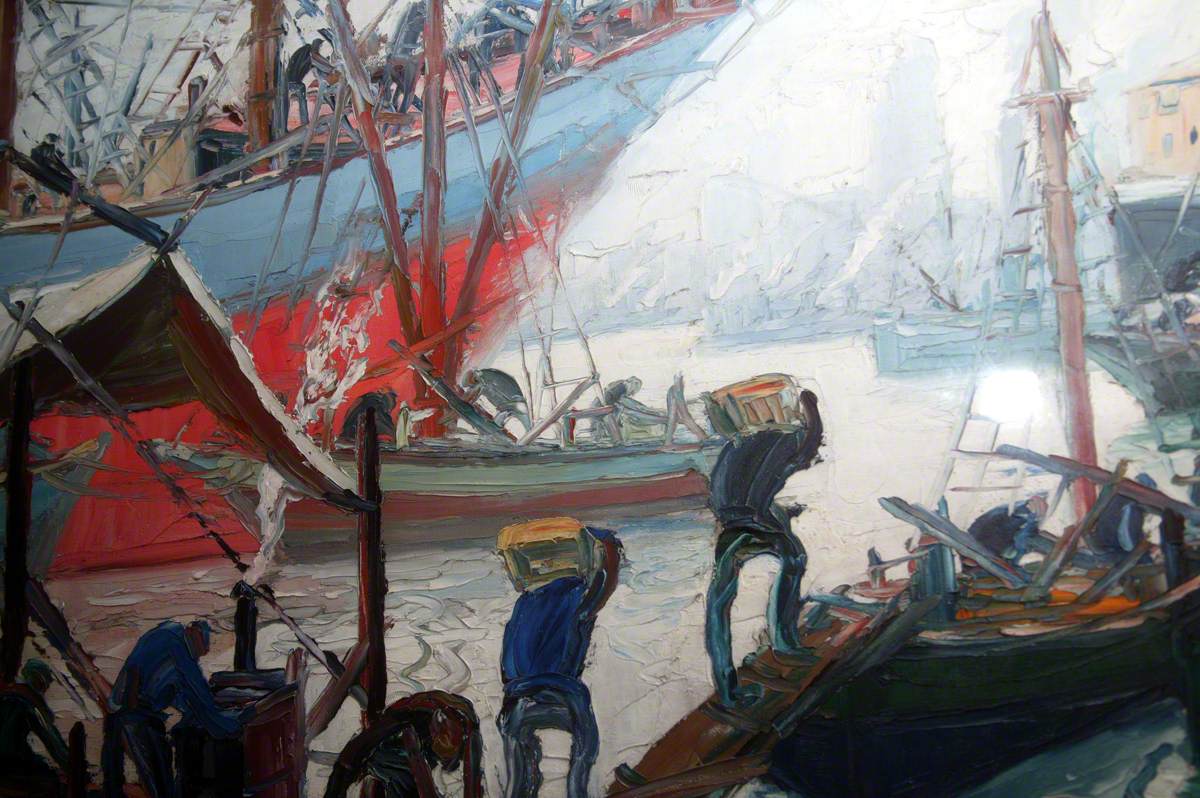The Glynn Vivian Art Gallery has got into the excellent habit of displaying a good mix of works from its permanent collection along a long wall in one of its upstairs rooms. This has the advantage of letting us see paintings that would not otherwise often see the light of day. When I was there a few days ago, the painting that took my eye was one I’d never noticed before.

The artist’s name, Benito Quinquela Martίn, didn’t strike me as a traditional Swansea one, though just conceivably the subject, stevedores working in a bustling seaport, and the title, Working at high pressure, could have Swansea associations. As it turns out, it doesn’t seem likely that either the artist or the painting had any Swansea connection.

Working at high pressure arrived in the Glynn Viv in 1930, having been ‘purchased from the Art Society Bureau’. Quite what the Bureau was I’m not sure, but possibly its function was to find homes in UK galleries for works of art. Martίn was an Argentinian artist, and in 1930 he visited London, exhibiting at the Burlington Gallery. Possibly our painting was shown there, and was then bought by the Bureau for Swansea? Maybe the curator of the Glynn Viv at the time, William Grant Murray, reckoned that its subject would interest the inhabitants of a port city on this side of the Atlantic. Other galleries, including National Museum Wales, Manchester Art Gallery and Birmingham Museums, hold paintings by Martίn. All seem to have arrived in 1930 or shortly after.
The location in our picture is La Boca, the port of Buenos Aires, which was the usual scene of Martίn’s paintings. In the centre, two workmen, their backs bowed under the weight of the heavy crates they carry behind their necks, walk up a gangplank to a masted boat. To the left is the bow of a ship, being loaded from a lighter below, and beyond it, in the hazy background, more vessels moored along the waterside. Bottom left, another worker stoops over an engine bellowing smoke into the air. Martίn’s treatment of the scene, and the human figures especially, is loose and lively, with the red hull of the ship adding a large slab of bright colour to the greys and browns of the rest of the piece.

Martίn’s life had an inauspicious start. In March 1890 he was abandoned as a newborn baby, with a note giving his baptismal name, at the doors of an orphanage. Nuns looked after him until he was adopted at the age of seven by Italian immigrants. He helped out in the family’s coal business, but clearly showed artistic talent, because he attended night classes at an art school in La Boca. Gradually he made a name for himself, coming to the attention (and patronage) of Marcelo Torcuato de Alvear, President of Argentina from 1922 to 1928. After that he enjoyed a successful career and much popularity until his death in 1977, aged 87 (he painted his own coffin with a La Boca theme). He was a generous philanthropist, especially in La Boca, and was partly responsible for transforming part of the area into the colour-filled streets that attract tourists today. A Foundation preserves his name and continues his community work.
The Swansea picture seems typical of the port paintings Martίn made around the same time. They give a vivid impression of the hurry and tumult of the quayside, and of the physical strength and endurance of the workers, who tended to be radical in their politics and supporters of Boca Juniors in their football allegiance. The golden age of the Argentine economy before the First World War had passed, but the country avoided the worst of the Depression, and trade was still buoyant.
Martίn’s style changed little over the years. Rincon de La Boca, painted in 1963 and now in the Football Museum, shows the same boats and belching chimneys, though maybe the port by this time has lost some of the intense ‘high pressure’ of its heyday. Martίn deserves to be remembered alongside other artists who celebrated the life of ports, like Whistler and Derain on the Thames.





Leave a Reply